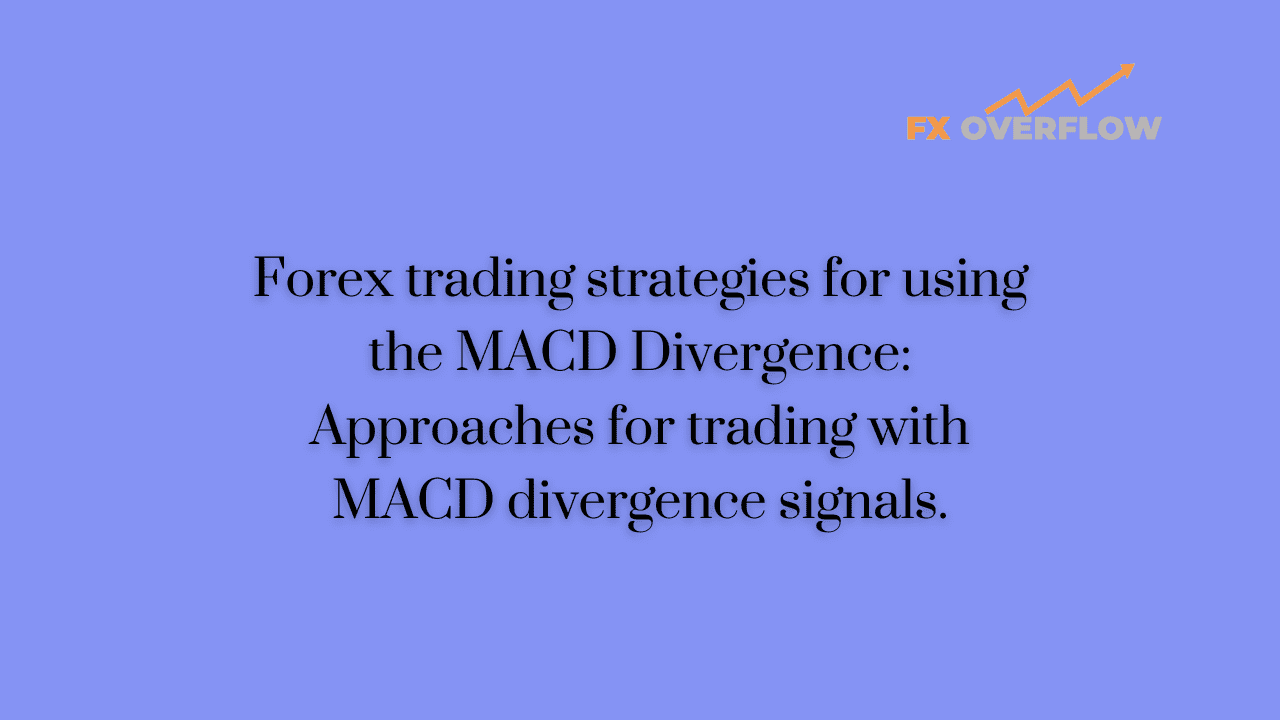Forex trading strategies for using the MACD Divergence: Approaches for trading with MACD divergence signals.
In the dynamic world of forex trading, success hinges on the ability to identify and capitalize on market trends. While there are a plethora of tools and indicators available to traders, one that has proven its mettle over time is the Moving Average Convergence Divergence (MACD) indicator. Within the realm of MACD, the concept of divergence stands out as a powerful strategy for making informed trading decisions. In this article, we will delve into the intricacies of MACD divergence and explore effective approaches to leverage this phenomenon for successful forex trading.

Table Content
I. Understanding the MACD Indicator and Divergence
1. Regular Bullish Divergence
2. Regular Bearish Divergence
II. Approaches for Trading with MACD Divergence Signals
1. Regular Bullish Divergence Strategy
2. Regular Bearish Divergence Strategy
3. Hidden Bullish and Bearish Divergence Strategies
III. Footnote
Understanding the MACD Indicator and Divergence
The MACD indicator is a versatile tool that combines moving averages with momentum analysis to provide a comprehensive view of market trends. Comprising two components – the MACD line and the signal line – it highlights the relationship between short-term and long-term price movements. When the MACD line crosses above the signal line, it generates a bullish signal, and conversely, a bearish signal when it crosses below.

Divergence, however, is where the MACD truly shines. Divergence occurs when the MACD indicator's movement diverges from the movement of the price chart. There are two main types of divergence:
1. Regular Bullish Divergence: This occurs when the price chart forms lower lows, but the MACD indicator forms higher lows. It suggests that although the price is trending downwards, the momentum might be shifting, indicating a potential reversal to the upside.
2. Regular Bearish Divergence: Conversely, this type of divergence materializes when the price chart forms higher highs, while the MACD indicator forms lower highs. It implies that while the price is climbing, the momentum is waning, signaling a possible impending downward reversal.
Approaches for Trading with MACD Divergence Signals
Trading using MACD divergence signals demands a blend of technical analysis, risk management, and a keen understanding of market psychology. Here are some effective strategies to consider:
1. Regular Bullish Divergence Strategy
When faced with a regular bullish divergence pattern, traders can adopt a multi-step approach to capitalize on potential opportunities:
a) Identification: Begin by identifying a consistent downtrend in the price chart, marked by lower lows. Concurrently, observe the MACD indicator forming higher lows.
b) Confirmation: Once identified, wait for additional confirmation signals. This can include the MACD line crossing above the signal line or other supporting technical indicators indicating a potential reversal.
c) Entry: After obtaining confirmation, consider entering a long position. However, exercise caution and ensure that other aspects of the market align with your analysis to mitigate risk.
d) Stop Loss: Place a well-defined stop loss slightly below the recent low in the price chart. This safeguards your capital in case the market takes an unexpected turn.
e) Take Profit: Set a target based on key resistance levels or previous swing highs. This helps secure profits and prevents greed from dictating your trading decisions.
2. Regular Bearish Divergence Strategy
When dealing with a regular bearish divergence pattern, a similar systematic approach can be employed:
a) Recognition: Identify a consistent uptrend in the price chart, characterized by higher highs. Simultaneously, observe the MACD indicator forming lower highs.
b) Validation: Seek further validation of the potential reversal by monitoring for supporting signals such as the MACD line crossing below the signal line or other complementary technical indicators.
c) Entry: Once validated, consider entering a short position, keeping in mind other market factors that might influence the trade.
d) Stop Loss: Protect your capital with a well-placed stop loss slightly above the recent high in the price chart.
e) Take Profit: Set a realistic take profit level based on key support levels or previous swing lows.
3. Hidden Bullish and Bearish Divergence Strategies
Apart from regular divergence, hidden divergence can also provide valuable insights into the market's direction. Hidden bullish divergence occurs when the price chart forms higher lows, while the MACD indicator forms lower lows. This indicates that even though the price might be temporarily trending downwards, the underlying momentum could be shifting upwards, implying a potential continuation of an uptrend.
On the other hand, hidden bearish divergence happens when the price chart forms lower highs, but the MACD indicator forms higher highs. This implies that despite short-term price rallies, the overall momentum is downward, hinting at the continuation of a downtrend.
Footnote
Leveraging MACD divergence signals can be a potent tool in a forex trader's arsenal, aiding in making informed trading decisions amidst the complexities of the market. Regular and hidden divergence patterns offer unique insights into potential reversals and trend continuations, enabling traders to position themselves advantageously.
However, it's important to note that no strategy is foolproof, and forex trading inherently carries risks. Therefore, meticulous risk management, continuous learning, and adapting to changing market conditions are crucial elements of successful trading. Additionally, combining MACD divergence strategies with other technical and fundamental analysis tools can provide a more comprehensive perspective, enhancing the overall decision-making process.
As with any trading strategy, practice, patience, and discipline are key. Novice traders should consider starting with a demo account to hone their skills before venturing into live trading. Remember, successful trading is not defined by isolated wins, but by consistent, well-informed decision-making over the long term.











Discussion